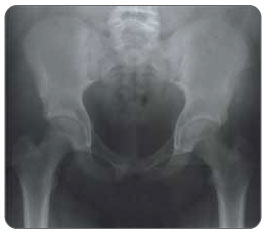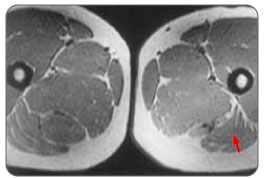Diagnosing your hamstring injury will help determine the course of action necessary for proper treatment. If you have suffered from a painful strain and you have lost power in your upper posterior thigh, it is very important to see a doctor. Although complete hamstring tears are not common, they can go unnoticed as the symptoms can be similar to a bad strain.
To help your doctor achieve a proper diagnosis, he/she will begin with a medical history about you, your current condition and symptoms. He/she will inquire about the intensity of your present pain, if you heard a popping noise when you first experienced your injury, the duration and type of symptoms and the limitations you are experiencing. Details about what instigated your problem, when it started, and whether or not you have ever had treatments for this or a similar condition in the past, will be very helpful in assessing your injury.

A physical examination will be performed to determine if you have any signs of a pulled hamstring. Your doctor will visually assess and feel the muscles, bones and other soft tissue in and around your hamstring, as well as your entire leg, pelvis and lower back, to evaluate sameness (symmetry), recognize differences and identify pain and tenderness. This will help to discover any abnormalities, such as mild or severe inflammation, fluid, bruising, bone or tissue deformity, and leg length discrepancies. He/she may ask you to complete a series of flexing and extending leg movements to see what motions cause pain, weakness, tightness, or instability. This will help to determine the location of your injury (in the muscle belly or near the attachment), test for the grade of your hamstring strain and any muscle imbalances. He/she will also evaluate your feet and gait (the way you walk) to determine if you overpronate, or have other alignment issues.
Most grade 1 or 2 hamstring strains don't require diagnostic testing, however these tests will help confirm if you have a grade 3 strain and/or will rule out other causes of hamstring pain.

X-rays will provide a two-dimensional image of the overall structure of your hamstring and upper leg (pelvis, femur and knee). They are helpful in identifying instability, avulsion fractures, abnormal bone shapes (bone spurs, calcifications or cysts, joint degeneration), and/or other leg problems.
CT scans (computed tomography) and diagnostic ultrasounds may be used to look internally at the hamstring muscles.

MRIs (magnetic resonance imaging) will provide more detailed information and will help to evaluate the soft tissues in and around your hamstring (muscles, tendons, ligaments, fascia, and other connective tissues). They can identify ligament or tendon damage, and can help to determine the extent of your injury, the grade of your tear or inflammation, as well as other associated conditions.
Hamstring injuries are frustrating to live with and healing can take a long time because it's difficult to give your leg the rest it needs. This is especially true for runners and other athletes that return to their sport too early. Re-injury is common but it prolongs recovery and may also lead to permanent damage and other conditions.
Treating your hamstring strain correctly is essential to getting rid of your pain and restoring function to your upper thigh. Proper treatment will get you back to regular activities sooner, stop your pain, and reduce the risk of future re-injury.
To restore strength and range of motion in your hamstrings, treatment should focus on preventing scar tissue formation and muscle atrophy (shrinkage and weakening of the muscle). This requires rest and the appropriate therapies at the right time. Almost all types of hamstring pulls and tears (except a complete hamstring rupture) can be properly treated with trusted therapies that are available for use at home. Complete ruptures usually require surgery. However, using these home therapies after surgery can help speed recovery, improve function, and increase range of motion in your hamstrings.
Learn more about Hamstring Muscle Strain Treatments by clicking here
AidYourHamstring advisors do not work on commission, so be assured you will only receive fair and objective information.
Product Advisors are available 9:00 am to 5:00 pm Eastern Standard Time Monday to Friday.
I want to learn more about Surgery & Post-Surgery Recovery
I want to learn more about Circulation Boost
I want to learn more about Ice & Heat: Which Is Better For Treatment?
I want to learn more about Stretching for the Hamstring
I want to learn more about Soft Tissue Injury Treatments
During your recovery, you will probably have to modify and/or eliminate any activities that cause pain or discomfort at the location of your soft tissue injury until the pain and inflammation settle. The more diligent you are with your treatment and rehabilitation, the faster you will see successful results!
Please be aware that this information is neither intended nor implied to be a substitute for professional medical advice. CALL YOUR HEALTHCARE PROVIDER IMMEDIATELY IF YOU THINK YOU MAY HAVE A MEDICAL EMERGENCY. Always seek the advice of your physician or other qualified health provider before using any of our outstanding products to make sure they are right for you and your condition or if you have any questions regarding a medical condition. Always see your doctor for a proper diagnosis as there are often many injuries and conditions (some very serious) that could be the cause of your pain.
© 2025 In.Genu Design Group, Inc. Contact Us